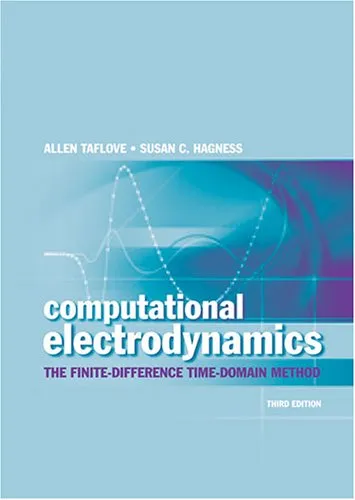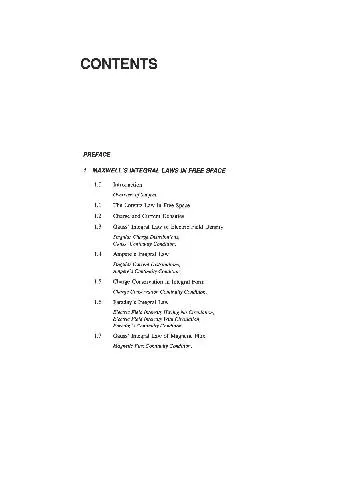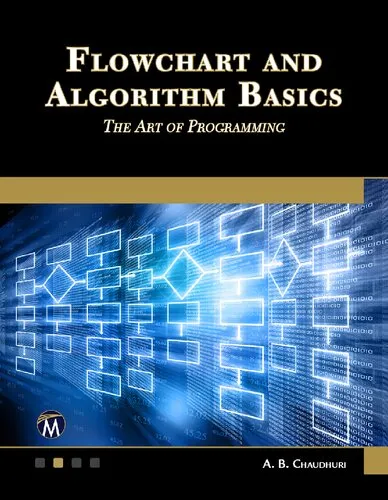Computational Electrodynamics: The Finite-Difference Time-Domain Method 2nd edition (Artech House Antennas and Propagation Library)
4.7
بر اساس نظر کاربران

شما میتونید سوالاتتون در باره کتاب رو از هوش مصنوعیش بعد از ورود بپرسید
هر دانلود یا پرسش از هوش مصنوعی 2 امتیاز لازم دارد، برای بدست آوردن امتیاز رایگان، به صفحه ی راهنمای امتیازات سر بزنید و یک سری کار ارزشمند انجام بدینکتاب های مرتبط:
معرفی کتاب Computational Electrodynamics: The Finite-Difference Time-Domain Method
کتاب Computational Electrodynamics: The Finite-Difference Time-Domain Method (ویرایش دوم) یکی از برجستهترین منابع علمی در زمینه الکترودینامیک محاسباتی است که با ارائه روش Finite-Difference Time-Domain (FDTD) به دانشجویان، محققان و مهندسان کمک میکند تا شبیهسازیهای دقیقتری از پدیدههای الکترومغناطیسی انجام دهند. این کتاب با ساختاری منطقی، استفاده از مثالهای کاربردی، و توضیحات شفاف تبدیل به یکی از منابع کلیدی برای درک عمیقتر از روش FDTD شده است.
خلاصهای از این کتاب
کتاب ابتدا به معرفی اصول پایهای الکترودینامیک ماکسول میپردازد و نحوه استفاده از معادلات مربوطه را در روش FDTD شرح میدهد. این روش به طور گسترده برای شبیهسازی تعامل الکترومغناطیس با مواد مختلف، طراحی آنتنها، و پژوهش در زمینههای اپتیک و امواج زیرمیلیمتری استفاده میشود. نویسندگان کتاب با جزئیات فنی و ریاضی، مفاهیم اساسی مانند نحوه گسستهسازی معادلات ماکسول، تفاوتهای زمانی و مکانی، پایداری عددی و حوزه کرانبندی شبیهسازیها را تشریح کردهاند.
ویرایش دوم این کتاب با اضافه کردن فصول جدیدی در زمینه absorbing boundary conditions، کاربردهای پیشرفته، و شبیهسازیهای سهبعدی، دید عمیقتر و عملیتری به فناوران و علاقهمندان به این حوزه ارائه میدهد. علاوه بر این، تصاویر و نمودارهای تعاملی و توضیحات جزئیتر به خوانندگان کمک میکند تا به راحتی پیچیدگیهای روش FDTD را درک و به کار گیرند.
نکات کلیدی کتاب
- درک اصول پایه معادلات ماکسول و نحوه گسستهسازی این معادلات در حوزه زمان
- معرفی دقیق و قدمبهقدم روش Finite-Difference Time-Domain و کاربردهای عملی آن
- پیشنهاد تکنیکهای بهینهسازی برای افزایش سرعت و دقت محاسبات
- تحلیل مقایسهای با دیگر روشهای محاسبات عددی در دینامیک الکترومغناطیس
- مباحث متعدد در زمینه جاذبهای مرزی مانند Perfectly Matched Layer (PML)
جملات مهم از کتاب
"FDTD has emerged as one of the most significant numerical techniques in computational electromagnetics."
"Simulation is not just about results; it's about understanding the physics behind an electromagnetic interaction."
چرا این کتاب ارزشمند است؟
اهمیت کتاب Computational Electrodynamics: The Finite-Difference Time-Domain Method از چند جنبه قابل بیان است. این اثر هم برای دانشجویان و محققان علوم پایه که به درک دقیقتر الکترومغناطیس علاقهمند هستند و هم برای مهندسان و فناورانی که در زمینه طراحی دستگاههای الکترومغناطیسی و اپتیک فعالیت میکنند، منبعی ضروری و اجتنابناپذیر است. از آنجایی که روش FDTD یکی از محبوبترین و قدرتمندترین روشهای عددی در شبیهسازی عددی محسوب میشود، این کتاب راهنمای بینظیری برای یادگیری و اعمال این تکنیک است.
همچنین، این کتاب پیشگامانه به خاطر توضیحات دقیق و دیدگاه عملیاش در زمینه کاربردهای روزمره، از صنعتی مثل ارتباطات و مخابرات گرفته تا تحقیقات زیستپزشکی، جایگاه خاصی یافته است.
ویرایش دوم این کتاب، با بهروزرسانیهای جامع و فصول جدید، به طور گستردهای برای متخصصان هر دو حوزه آکادمیک و صنعتی توصیه میشود.
Introduction to Computational Electrodynamics: The Finite-Difference Time-Domain Method (2nd Edition)
This second edition of Computational Electrodynamics: The Finite-Difference Time-Domain Method offers a comprehensive and updated exploration of one of the most widely used methods in computational electrodynamics: the Finite-Difference Time-Domain Method (FDTD). Authored by Allen Taflove and Susan C. Hagness, this book is regarded as a cornerstone in the development of FDTD techniques, providing theoretical underpinnings and practical computations for engineers, researchers, and students working in the fields of electromagnetics, photonics, antenna design, and more.
The book builds upon the solid foundation laid out in its first edition, expanding the scope to include groundbreaking advancements in both the theory and practical implementation of the FDTD method. Simultaneously rigorous and accessible, this text allows readers to bridge the gap between foundational theory and modern computational challenges, offering insights into real-world applications that illuminate the power and flexibility of this numerical simulation approach.
Detailed Summary of the Book
The book is structured to guide the reader through the complete landscape of computational electrodynamics using the FDTD method. It begins with the basics of Maxwell’s equations, setting the stage with a thorough mathematical background suitable for readers of all technical levels. Significant emphasis is placed on understanding the leap from continuous equations to discrete numerical approximations, a core tenet of FDTD.
The authors then transition into the detailed implementation of the FDTD method. This includes derivations of finite-difference equations, time-stepping algorithms, and practical considerations for accurate simulations. The text explores boundary conditions like perfectly matched layers (PML) to terminate computational domains and reduce reflection artifacts.
Special topics include advanced FDTD techniques for handling nonlinear materials, subgridding, and multi-scale problems. Applications of the FDTD method are showcased through the design of antennas, microstrip circuits, optical waveguides, and interactions of light with nanostructures. The material is accompanied by explanatory figures, illustrative examples, and pseudo-code, ensuring the clarity and usability of the presented methods.
In this edition, new chapters and sections have been added, including material on dispersive media, higher-order time-domain techniques, and advances in computational resources, such as parallel processing and GPU acceleration. These updates keep the book relevant in contemporary settings where computational speed and accuracy are paramount. In addition, the second edition delves deeply into topics like photonic crystal simulation and biomedical applications, underscoring the universal applicability of FDTD in various electromagnetic domains.
Key Takeaways
- A comprehensive understanding of Maxwell’s equations and their relevance to computational electrodynamics.
- Step-by-step tutorials on implementing FDTD methods, complete with pseudo-code for practical implementation.
- Insights into advanced computational techniques, such as perfectly matched layers (PML) and sub-cell methods.
- Real-world applications ranging from antenna design to light-matter interactions for nanostructures.
- New sections dedicated to modern challenges, including GPU acceleration and biomedical applications.
Famous Quotes from the Book
"The Finite-Difference Time-Domain (FDTD) method is, at its core, an intuitive exploration of the solutions to Maxwell’s equations—a revealing lens through which we can understand how electromagnetic waves behave in complex environments."
"Through accurate numerical approximations, we transform the abstraction of electromagnetic physics into tangible, actionable designs."
"The true power of FDTD lies in its simplicity and universality, enabling us to tackle problems ranging from the terahertz scale of photonics to the biomedical scale of human tissue."
Why This Book Matters
The impact of Computational Electrodynamics cannot be overstated. This book has redefined how engineers and researchers solve electromagnetic problems, democratizing highly advanced tools like the FDTD method through clear explanations, robust derivations, and practical guidance. By addressing the challenges encountered in applying Maxwell’s equations to real-world problems, the authors empower readers to think creatively and solve complex issues with confidence.
Moreover, the second edition acknowledges the rapid progression of technology, incorporating the latest advancements to ensure relevance in modern research and industries. The ability to accurately simulate electromagnetic phenomena is central to developing cutting-edge technologies in communications, defense, optics, and more. Thus, this book serves as an essential reference for anyone contributing to innovation in these fields.
Whether you are a seasoned professional or a student entering the field, this book offers value at every level, from a strong foundational understanding of FDTD to its application in sophisticated research. It is a definitive text for computational electrodynamics, designed to educate, challenge, and inspire.
دانلود رایگان مستقیم
شما میتونید سوالاتتون در باره کتاب رو از هوش مصنوعیش بعد از ورود بپرسید
دسترسی به کتابها از طریق پلتفرمهای قانونی و کتابخانههای عمومی نه تنها از حقوق نویسندگان و ناشران حمایت میکند، بلکه به پایداری فرهنگ کتابخوانی نیز کمک میرساند. پیش از دانلود، لحظهای به بررسی این گزینهها فکر کنید.
این کتاب رو در پلتفرم های دیگه ببینید
WorldCat به شما کمک میکنه تا کتاب ها رو در کتابخانه های سراسر دنیا پیدا کنید
امتیازها، نظرات تخصصی و صحبت ها درباره کتاب را در Goodreads ببینید
کتابهای کمیاب یا دست دوم را در AbeBooks پیدا کنید و بخرید
1318
بازدید4.7
امتیاز0
نظر98%
رضایتنظرات:
4.7
بر اساس 0 نظر کاربران
Questions & Answers
Ask questions about this book or help others by answering
No questions yet. Be the first to ask!








![The Ultimate iOS Interview Playbook: Conquer Swift, frameworks, design patterns, and app architecture [Team-IRA]](https://s3.refhub.ir/images/thumb/The_Ultimate_iOS_Interview_Playbook__Conquer__29925.webp)







